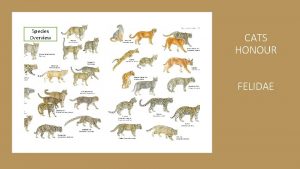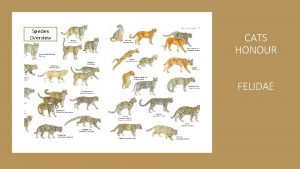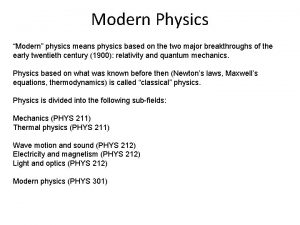The Physics of Cats or How Cats Almost



































- Slides: 35

The Physics of Cats or, How Cats (Almost) Always Land on Their Feet Emily Russell Monday, March 5, 2007

Overview • • Debunking the Myth The Righting Reflex Drag and Air Resistance Angular Momentum

Debunking the Myth It has long been speculated that a cat will always fall on its feet.

Debunking the Myth But how does the cat do this? Does it know how to push off as it begins to fall? Does it use air resistance to turn itself?

Debunking the Myth Étienne Jules Marey (1830 -1904) Marey was a French doctor, and one of the pioneers of photography and chronophotography.

Debunking the Myth In 1894, in response to a call for information from the Academy of Science in Paris, Marey took several videos of falling cats.

The Righting Reflex The righting reflex is innate in cats, and develops between the ages of 3 and 7 weeks. This instinct allows them to orient themselves in the air before hitting the ground.

The Righting Reflex Cats depend largely on visual cues to right themselves. Their vestibular system also allows them to tell which direction is up.

Drag and Air Resistance In 1553, Giambattista Benedetti (1530 -1590) determined that all objects fall with the same acceleration. This is due to the force of Earth’s gravity, After falling for a time t, the object’s velocity is

Drag and Air Resistance But this is not the whole story! A falling object is slowed by air resistance.

Drag and Air Resistance The force due to air resistance is given by: where, Cd ρ A v = coefficient of drag (around 0. 2) = density of air = area of object = velocity of object

Drag and Air Resistance Since the air resistance acts upwards, it tries to slow down the speed at which the object falls. Terminal velocity is reached when the downward force of gravity and the upward force from air resistance are the same:

Drag and Air Resistance Terminal velocity: v ~ 614 mph (maximum speed of skydiver) v ~ 120 mph (normal skydiver) v ~ 60 mph (cat)

Drag and Air Resistance A skydiver’s parachute has a much larger area than the diver himself, so it slows down the terminal velocity.

Drag and Air Resistance A cat can change its terminal velocity by spreading out its limbs and increasing its area. The bulk of its fur also helps. This splayed position is often compared to the flying squirrel.

Angular Momentum A cat can determine which way is up, and has a slow enough terminal velocity that it can survive a fall – but how does it turn itself to land feet-first? This problem is harder than it looks because of angular momentum.

Angular Momentum Angular momentum is a quantitative measure of how much an object is rotating. The equation for angular momentum is: m = mass v = velocity r = radius of object

Angular Momentum One of the most basic laws of physics is the conservation of angular momentum: the angular momentum of an object cannot change unless outside forces act on it.

Angular Momentum Skaters use this conservation of angular momentum to speed up their spins: large r, small v small r, large v

Angular Momentum The only outside forces acting on the cat are gravity and air resistance. These forces are the only way for the cat to change its angular momentum and rotate. Gravity acts on the center of mass of the cat, and does not change its angular momentum.

Angular Momentum The cat could potentially use air resistance to change its rotation and turn itself to fall feet-first. This was a popular hypothesis for a long time, but turns out to be wrong. So how does the cat turn over if it can’t rotate?

Angular Momentum The answer: the cat’s entire body cannot rotate at once. . . . But cats are very flexible!!

Angular Momentum A cat begins by spreading its hind legs very wide, and pulling in its front legs. It can then turn its front half quickly in one direction, while its back half moves slowly in the other direction.

Angular Momentum Let’s look at the cat’s angular momentum: front half – v is large and positive r is small back half – v is small and negative r is large total –

Angular Momentum

Angular Momentum The front and the back of the cat have angular momentum in opposite directions, so added together, the total angular momentum of the cat remains zero.

Angular Momentum The cat then reverses the process: it spreads its front legs and pulls in its hind legs. It can then turn its back half quickly to catch up with the front half, while the front half turns slowly backward.

Angular Momentum The result: the cat turns over to land on its feet, but its total angular momentum is always zero; its entire body never rotates at once!

How a Cat Lands on Its Feet

How a Cat Lands on Its Feet A study was released in the Journal of the American Veterinary Medical Association in 1987 of 132 cats which had fallen from high-rise windows in New York. The average fall height was 5. 5 stories. 90% of the cats survived.

How a Cat Lands on Its Feet Above a fall height of 7 stories (around 70 feet), the number of injuries the cat sustained actually decreased. This is because once it has turned over and reach terminal velocity, the cat relaxes its muscles, so that its landing is softer.

How a Cat Lands on Its Feet Summary: sequence of events • cat determines which way is up • cat rotates front half of body to face down • cat rotates back half of body to face down • cat spreads out and relaxes its muscles • cat lands safely

DO NOT TRY THIS AT HOME Although a falling cat has a very good chance of landing on its feet, many cats have died by falling. Cats that survive are often injured, sometimes severely.

Further Questions • What triggers the “righting reflex” to kick in? • Can a cat reorient itself with its eyes closed? and most importantly: • If you attach a piece of toast butter-side-up to the back of a cat and drop it, will the cat land on its feet, or will the toast land butter -side-down?

References • • Physlink http: //www. physlink. com/Education/Ask. Experts/ae 411. cfm Damn Interesting, “High Rise Syndrome” http: //www. damninteresting. com/? p=709 The Straight Dope http: //www. straightdope. com/classics/a 5_190. html http: //www. verrueckte-experimente. de/leseproben_e. html Pet. Place, “Why Cats Land on Their Feet, ” http: //www. petplace. com/cats/why-cats-land-on-their-feet/page 1. aspx# http: //www. ocf. berkeley. edu/~barneye/kitty. html “Méchanique Animale”, La Nature, Vol. 1119, 10 November 1894, p. 596, http: //cnum. cnam. fr/CGI/fpage. cgi? 4 KY 28. 43/0373/100/532/0/0 Wikipedia, http: //en. wikipedia. org/wiki/Main_Page articles: “Cat Righting Reflex”; “Étienne-Jules Marey”; “Vestibular System”; “Giambattista Benedetti”; “Terminal Velocity” No cats were harmed in the making of this presentation.
 University physics with modern physics fifteenth edition
University physics with modern physics fifteenth edition Ia topics for physics
Ia topics for physics Why does it happen
Why does it happen Vẽ hình chiếu vuông góc của vật thể sau
Vẽ hình chiếu vuông góc của vật thể sau Frameset trong html5
Frameset trong html5 101012 bằng
101012 bằng Thế nào là mạng điện lắp đặt kiểu nổi
Thế nào là mạng điện lắp đặt kiểu nổi Lời thề hippocrates
Lời thề hippocrates Vẽ hình chiếu đứng bằng cạnh của vật thể
Vẽ hình chiếu đứng bằng cạnh của vật thể Tư thế worm breton
Tư thế worm breton đại từ thay thế
đại từ thay thế Quá trình desamine hóa có thể tạo ra
Quá trình desamine hóa có thể tạo ra Sự nuôi và dạy con của hổ
Sự nuôi và dạy con của hổ Các châu lục và đại dương trên thế giới
Các châu lục và đại dương trên thế giới Dot
Dot Bổ thể
Bổ thể Thế nào là sự mỏi cơ
Thế nào là sự mỏi cơ Phản ứng thế ankan
Phản ứng thế ankan Thiếu nhi thế giới liên hoan
Thiếu nhi thế giới liên hoan Phối cảnh
Phối cảnh Chúa yêu trần thế alleluia
Chúa yêu trần thế alleluia điện thế nghỉ
điện thế nghỉ Một số thể thơ truyền thống
Một số thể thơ truyền thống Hệ hô hấp
Hệ hô hấp Công của trọng lực
Công của trọng lực Số.nguyên tố
Số.nguyên tố Tỉ lệ cơ thể trẻ em
Tỉ lệ cơ thể trẻ em đặc điểm cơ thể của người tối cổ
đặc điểm cơ thể của người tối cổ Các châu lục và đại dương trên thế giới
Các châu lục và đại dương trên thế giới ưu thế lai là gì
ưu thế lai là gì Thẻ vin
Thẻ vin Kể tên các môn thể thao
Kể tên các môn thể thao Tư thế ngồi viết
Tư thế ngồi viết Cái miệng nó xinh thế
Cái miệng nó xinh thế Hình ảnh bộ gõ cơ thể búng tay
Hình ảnh bộ gõ cơ thể búng tay Mật thư tọa độ 5x5
Mật thư tọa độ 5x5



























































